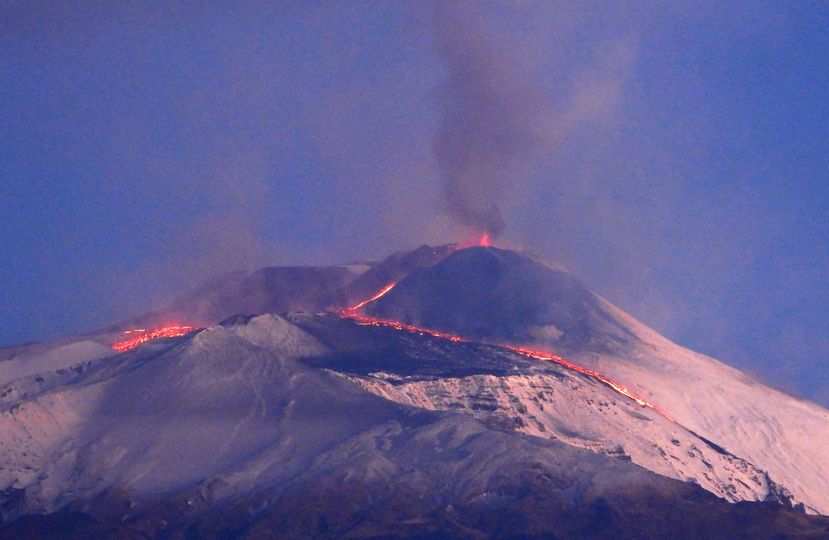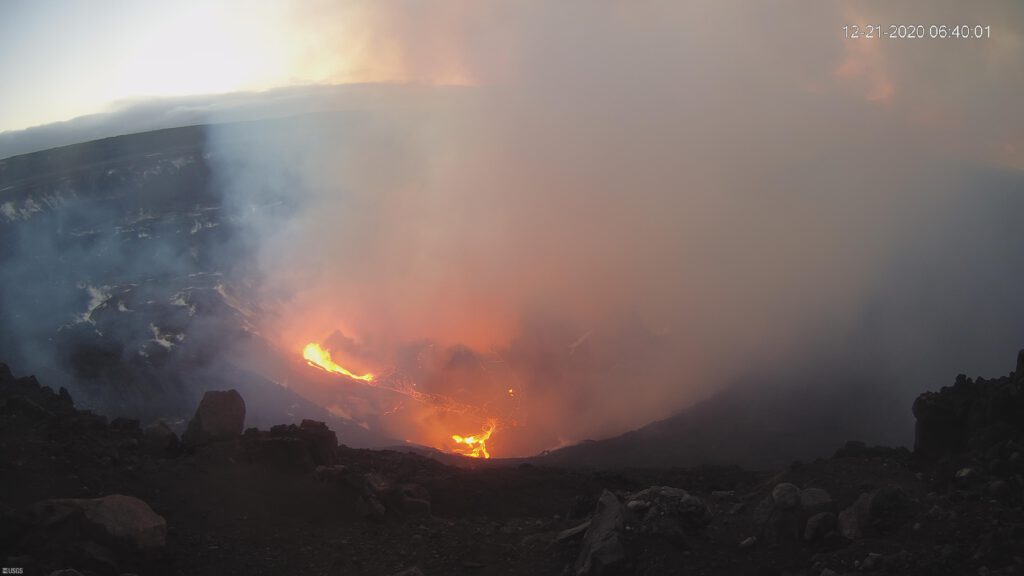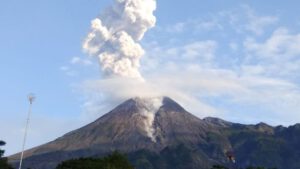 In the early morning hours today, a pyroclastic flow descended from Merapi on Java (Indonesia). It flowed through Kali Krasak and covered a sliding distance of about 1500 meters. Volcanic ash rose about 500 m high and drifted in an easterly direction. The seismograms registered a signal with a maximum amplitude of 60 mm and 150 seconds duration. Yesterday, seismicity picked up again somewhat and 200 shocks were detected. Among them were some hybrid and volcanotectonic earthquakes. There could be 2 reasons for the general downward trend in seismicity: either less magma is rising, or the ascent paths are clear. The latter would result in faster dome growth. The pic comes from the archive.
In the early morning hours today, a pyroclastic flow descended from Merapi on Java (Indonesia). It flowed through Kali Krasak and covered a sliding distance of about 1500 meters. Volcanic ash rose about 500 m high and drifted in an easterly direction. The seismograms registered a signal with a maximum amplitude of 60 mm and 150 seconds duration. Yesterday, seismicity picked up again somewhat and 200 shocks were detected. Among them were some hybrid and volcanotectonic earthquakes. There could be 2 reasons for the general downward trend in seismicity: either less magma is rising, or the ascent paths are clear. The latter would result in faster dome growth. The pic comes from the archive.
Eruptions
News about eruptions and volcanoes can be found in this category. It is updated frequently. Volcano expert and journalist Marc Szeglat reports live from his expeditions to volcanoes.
Etna: Earthquake near crater
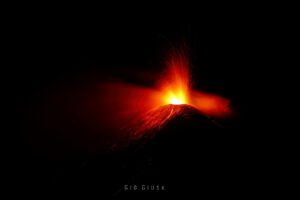 The Italian volcano Etna continues to be explosively active. The main scene of the action is the southeast crater. Here, glowing tephra rises up to 250 m above crater level. Strombolian eruptions are also observed from Voragine. A recent Sentinel satellite photo reveals 4 thermal anomalies in the summit area: the largest marks the southeast crater, then there are smaller anomalies in Bocca Nuova and in Voragine. Last, but not least, Northeast Crater is also emitting heat. MIROVA registered today a moderate thermal radiation with 22 MW power. Several earthquakes manifested themselves in the area of the summit. On the map they are marked in the northeast. If you look more closely, you can see a cluster of microquakes also south of the crater complex. The tremor is high and I expect more activity.
The Italian volcano Etna continues to be explosively active. The main scene of the action is the southeast crater. Here, glowing tephra rises up to 250 m above crater level. Strombolian eruptions are also observed from Voragine. A recent Sentinel satellite photo reveals 4 thermal anomalies in the summit area: the largest marks the southeast crater, then there are smaller anomalies in Bocca Nuova and in Voragine. Last, but not least, Northeast Crater is also emitting heat. MIROVA registered today a moderate thermal radiation with 22 MW power. Several earthquakes manifested themselves in the area of the summit. On the map they are marked in the northeast. If you look more closely, you can see a cluster of microquakes also south of the crater complex. The tremor is high and I expect more activity.
Merapi: Seismic drops off
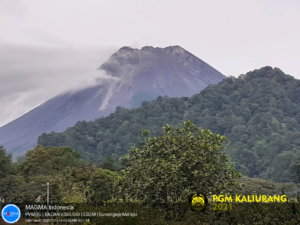 Seismicity on Merapi has dropped sharply in the last two days. It halved from almost 400 daily quakes to less than 200 tremors. That still sounds like a lot, however, these are almost all rockfall signals that are being registered. Hybrid and volcanotectonic quakes were hardly detected. Just these quakes are caused by rising magma. So it could be that the magma ascent stopped and the current dome growth phase ends. The next few days will show whether the volcano is only taking a short breather or whether it will actually take a longer break.
Seismicity on Merapi has dropped sharply in the last two days. It halved from almost 400 daily quakes to less than 200 tremors. That still sounds like a lot, however, these are almost all rockfall signals that are being registered. Hybrid and volcanotectonic quakes were hardly detected. Just these quakes are caused by rising magma. So it could be that the magma ascent stopped and the current dome growth phase ends. The next few days will show whether the volcano is only taking a short breather or whether it will actually take a longer break.
Etna: High thermal signal
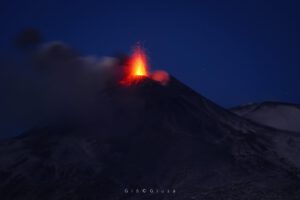 Sicilian Etna is very hot today, emitting heat with a power of 203 MW. Currently, on the thermalcam, you can see that a lot of glowing tephra is on the way on the eastern flank of the southeast crater cone. Strong strombolian eruptions from Southeast Crater were photographed again tonight. In addition, Voragine and Northeast Crater joined in. Such intense summit activity from multiple craters is not produced by Etna every day. Moreover, the activity could increase to a paroxysm. The tremor is on the border of the red zone. Seismicity is dominated by the shallow earthquakes east of the crater that I reported on yesterday. There seems to be some magma on the way here.
Sicilian Etna is very hot today, emitting heat with a power of 203 MW. Currently, on the thermalcam, you can see that a lot of glowing tephra is on the way on the eastern flank of the southeast crater cone. Strong strombolian eruptions from Southeast Crater were photographed again tonight. In addition, Voragine and Northeast Crater joined in. Such intense summit activity from multiple craters is not produced by Etna every day. Moreover, the activity could increase to a paroxysm. The tremor is on the border of the red zone. Seismicity is dominated by the shallow earthquakes east of the crater that I reported on yesterday. There seems to be some magma on the way here.
Merapi: Pyroclastic flow went off
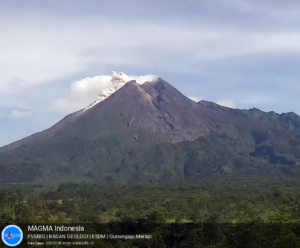 A small pyroclastic flow went off at the Indonesian volcano Merapi yesterday. It generated a seismic signal of 120 seconds duration and with a maximum amplitude of 45 mm. Contrary to expectations, it did not flow over the southern flank, where the large vent is located, but over a field further west. This is where most of the pyroclastic flows from the 2006 eruption departed. Looking at satellite photos, one can see that steam is also rising from the northwest crater area; this is where the dome appears to be growing the most. The VAAC detected volcanic ash at 3000 m altitude. A total of 440 earthquakes were registered.
A small pyroclastic flow went off at the Indonesian volcano Merapi yesterday. It generated a seismic signal of 120 seconds duration and with a maximum amplitude of 45 mm. Contrary to expectations, it did not flow over the southern flank, where the large vent is located, but over a field further west. This is where most of the pyroclastic flows from the 2006 eruption departed. Looking at satellite photos, one can see that steam is also rising from the northwest crater area; this is where the dome appears to be growing the most. The VAAC detected volcanic ash at 3000 m altitude. A total of 440 earthquakes were registered.
Kilauea: Lava lake rose
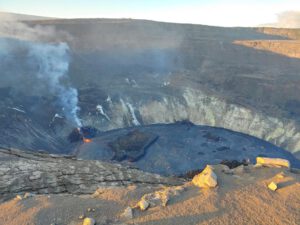 At Kilauea in Hawaii, the lava lake continues to be active and its level has risen. Latest measurements showed a depth of 192 m. Thus, it rose 2 m above its edge, which is defined by a crust of solidified lava. Accordingly, the deflation is increased. Its dimensions are 720×560 m. The lava lake is fed from 2 vents on the west wall. A hornito has formed on the upper one, which has continued to grow. The HVO describes that strombolian lava patterning is observed there. The lower vent is below the lake surface and produces much more lava. It produces a dome-like bulge in the lake surface. Seismicity is slightly elevated and tremors are recorded. Approximately 3500-6500 tons of sulfur dioxide are emitted daily. This is in the range of the 2018 lava lake. MIROVA registers very high thermal radiation. It is mostly above 2000 MW power.
At Kilauea in Hawaii, the lava lake continues to be active and its level has risen. Latest measurements showed a depth of 192 m. Thus, it rose 2 m above its edge, which is defined by a crust of solidified lava. Accordingly, the deflation is increased. Its dimensions are 720×560 m. The lava lake is fed from 2 vents on the west wall. A hornito has formed on the upper one, which has continued to grow. The HVO describes that strombolian lava patterning is observed there. The lower vent is below the lake surface and produces much more lava. It produces a dome-like bulge in the lake surface. Seismicity is slightly elevated and tremors are recorded. Approximately 3500-6500 tons of sulfur dioxide are emitted daily. This is in the range of the 2018 lava lake. MIROVA registers very high thermal radiation. It is mostly above 2000 MW power.
Etna erupts permanent ash cloud
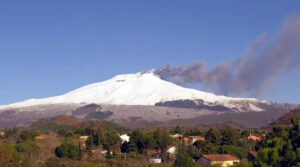 Etna in Sicily is perky this morning, erupting ash clouds from the southeast crater cone. Strong winds push the ash into the Valle del Bove. The action can be followed nicely on the live cams. Thermal imaging cameras show that incandescent cinders are also being produced. The tremor is still low and it does not look like it is the starting phase of a paroxysm. However, it cannot be ruled out that the activity will increase. Already at night the volcano was very active and produced strong strombolian eruptions from several craters.
Etna in Sicily is perky this morning, erupting ash clouds from the southeast crater cone. Strong winds push the ash into the Valle del Bove. The action can be followed nicely on the live cams. Thermal imaging cameras show that incandescent cinders are also being produced. The tremor is still low and it does not look like it is the starting phase of a paroxysm. However, it cannot be ruled out that the activity will increase. Already at night the volcano was very active and produced strong strombolian eruptions from several craters.
Soufrière St. Vincent: Lava dome growth in the Caribbean
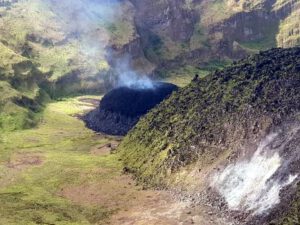 A moderate thermal anomaly has been observed on the Caribbean island of St. Vincent for 3 days. MIROVA detects a thermal radiation with powers between 11-18 MW. The hotspot is located near the northwest coast of the island and is associated with the Soufrière volcano. In our FB group, posts from local media have now been shared, according to which a new lava dome started to grow. It is pushing out from the flank of an older dome that is already overgrown. A first dome grew during an eruption in 1971/72 and was replaced by a new dome during another eruption in 1979.
A moderate thermal anomaly has been observed on the Caribbean island of St. Vincent for 3 days. MIROVA detects a thermal radiation with powers between 11-18 MW. The hotspot is located near the northwest coast of the island and is associated with the Soufrière volcano. In our FB group, posts from local media have now been shared, according to which a new lava dome started to grow. It is pushing out from the flank of an older dome that is already overgrown. A first dome grew during an eruption in 1971/72 and was replaced by a new dome during another eruption in 1979.
There was already a fumarole field near the current dome. Seismicity had been elevated since November. The alert status was set to “orange” and a restricted area was declared. The information comes from the UWI Seismic Research Centre.
Third paroxysm on Etna
At Etna in Sicily, activity increased again at night. INGV reported an increase in strombolian activity. Around 02:50 (UCT), at least 2 vents of Southeast Crater were active. Then, at 03:15, lava began flowing again from the vent in the southwest flank of the crater. A little later, the inclinometers indicated ground deformation in the form of inflation. Tremor amplitude increased significantly and another paroxysm began. 2 lava fountains were generated. Lava flows headed south and east, into the Valle del Bove. There, a phreatic explosion occurred when the lava encountered a large amount of meltwater originating from the snow on the flank. In the morning hours, the activity subsided. Currently, the lava flow in the south is still somewhat active.
Kilauea builds a lava lake
The eruption at Kilauea continues, but the rate of production has decreased. Lava still flows from the crack in the crater wall, feeding a growing lava lake. At the rim, the lava remains molten; at the center, it is cooling. Whether the lake can sustain itself in the long term depends on whether it manages to flood the vent. Then only comparatively little lava needs to flow in to keep the whole system going. Of course, there must also be circulation, and lava must be able to flow out again. In the past, lava flowed out of the caldera toward Puʻu ʻŌʻō.
The HVO graded Kilauea to “yellow” alert status. An “orange” alert level is in effect for air traffic. Phreatomagmatic eruptions are apparently still considered possible, which could produce high rising ash clouds.
